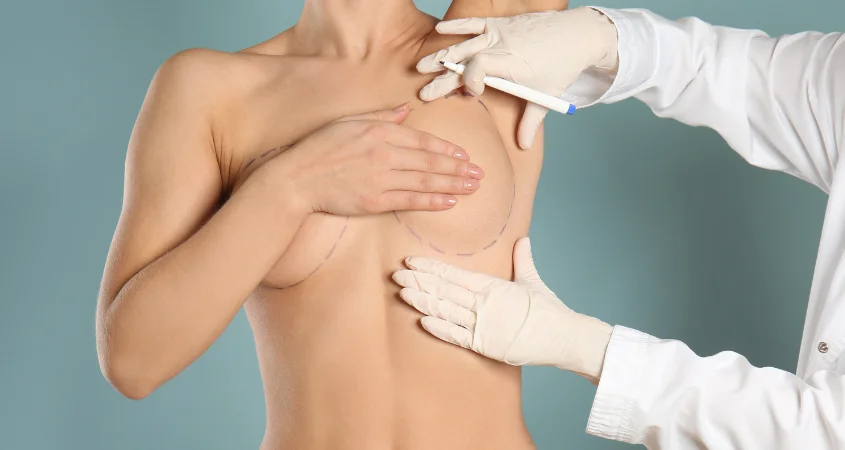Scarless Breast Augmentation: Cost, Myths & Reality
By Partington Plastic Surgery on May 01, 2024 in Breast Augmentation, Breast Implants

Introduction
Breast augmentation has become one of the most sought-after cosmetic procedures worldwide due to the increasing desire for aesthetic perfection and body confidence. The surge in popularity has paved the way for a groundbreaking shift toward “scarless breast augmentation” or “no scar breast augmentation.” Traditional methods involve incisions that leave noticeable scars, which is a common concern among patients.
However, innovative techniques aim to minimize scarring or make it completely invisible, making enhancements appear more natural while being less invasive. This article aims to explore public perception regarding this approach as well as technological advancements enabling such treatments.

It also discusses implications on both patient and surgeon aspects through an extensive analysis; covering procedural details from start until completion alongside possible outcomes based on patient feedbacks/responses over time-frame with considerations towards future prospects within today’s advancing landscape across the cosmetic surgery advancement industry segments alike.
Background and Historical Context
Breast augmentation has significantly evolved since its inception in the late 19th century, shifting from rudimentary techniques to advanced medical practices. Initially, paraffin injections in the late 1800s led to severe complications, such as infections and paraffinomas, causing the method to be abandoned. The introduction of the silicone breast implants in the 1960s, first used on Timmie Jean Lindsey, marked a transformative era in cosmetic surgery, offering a more natural feel. However, issues such as leakage and associated systemic diseases prompted safety concerns.
The 1990s and early 2000s saw the development of cohesive gel silicone implants (“gummy bear” silicone breast implants), which maintained their shape better and minimized leakage risks.
Advancements in surgical techniques, including smaller incisions and endoscopic technology, have reduced scarring and accelerated healing. Furthermore, non-invasive methods like fat transfer from liposuction offer enhancements with minimal scarring.
Recent innovations continue to focus on integrating materials more seamlessly with body tissues, promoting faster recovery and reducing scarring in what is termed “scarless” breast augmentation.

Overall, the evolution from hazardous early experiments to today’s sophisticated and safer procedures highlights the progress in cosmetic surgery, aiming to ensure efficacy, safety, and aesthetic quality in breast augmentation.
Analysis of Current Techniques of Breast Implant
The technique of fat grafting
Fat grafting is an emerging technique in the field of breast augmentation that aims to provide scar-free results. The procedure entails extracting adipose tissue from a specific region of the patient’s body (often the belly, thighs, or buttocks) by liposuction, and then administering it into the breasts via injection.
This methodology not only bypasses the need for synthetic breast implants but also offers a dual advantage: delineating the region from which the adipose tissue is extracted and augmenting the dimensions and form of the breast without conventional surgical cuts.
The scientific justification for the effectiveness of fat grafting in scarless breast augmentation is rooted in its usage of the body’s own tissues, which facilitates a more seamless integration and authentic sensation, although there may be variations in the rates of retention and volume by breast augmentation technique.
Myths Surrounding Scarless Breast Augmentation
There are a number of misunderstandings and irrational expectations around scarless breast augmentation. Here, to help you grasp the process better, we’ve identified several myths and compared them with scientific evidence:

Myth 1: There are no visible scars from a scarless breast augmentation.
Though its name suggests otherwise, scarless breast augmentation usually refers to strategically placing or minimizing scars in areas where they are less obvious. Incisions placed in less noticeable places, including beneath the breast fold or through the armpit, can greatly minimize apparent scarring, but scarring is unavoidable as the body heals. This is according to study published in the Aesthetic Surgery Journal.
Myth 2: Compared to standard techniques, the outcomes of scarless breast augmentation are less natural.
Numerous studies refute this notion, showing that scarless breast augmentation procedures may provide outcomes that seem natural and complement the features of the body when carried out by expert surgeons. According to research published in the Journal of Plastic, Reconstructive & Aesthetic Surgery, implants positioned precisely or autologous fat transfer can closely resemble natural breast tissue in terms of feel and appearance.
Myth 3: It takes less time and suffering to recover from a scarless breast augmentation.
Research indicates that while less intrusive methods can shorten recovery times and minimize discomfort, individual differences exist in how much of a reduction they can achieve. Recovery is still contingent upon a number of variables, including as the patient’s condition, the kind of augmentation used, and compliance with aftercare guidelines.
The expectations and decision-making of patients might be greatly impacted by false information on scarless breast augmentation. It is dishonest to persuade patients who search for “scarless breast augmentation near me” into believing they may have bigger breasts without any visible scars at all.
The limitations and potential of scarless breast augmentation based on current scientific research must be explained by healthcare providers to moderate expectations and deliver correct information. Giving patients adequate education on these topics reduces the possibility of post-surgery disappointment and helps to guarantee patient happiness with the results.
Reality: Outcomes and Patient Satisfaction

Recent studies and reviews have consistently underscored the transformative impact of breast augmentation procedures, particularly focusing on the innovative “no scar” techniques. According to a comprehensive analysis published in the Journal of Cosmetic Dermatology, over 90% of patients who underwent a “no scar” breast augmentation reported high levels of satisfaction with the aesthetic outcomes.
This statistic is particularly noteworthy in comparison to traditional methods, which, while still maintaining high satisfaction rates, often hovered around 85%. Furthermore, clinical outcomes have shown a significant reduction in recovery time and post-operative complications, with infection rates dropping to less than 2% among patients choosing the “no scar” option, as opposed to the 5% observed in conventional surgeries.
Regarding patient satisfaction, an upward trend in satisfaction rates over the past five years, with the “no scar” breast augmentation method consistently outperforming traditional techniques in terms of aesthetic outcomes, recovery process, and overall patient experience.
Natural Look
Confident Beauty
24 Hour Rapid Recovery, Muscle Sparing.

Comparative Analysis of Traditional Breast Augmentation and Scarless Breast Augmentation Procedure
Scarless breast augmentation is a new cosmetic surgery therapy. This method is growing increasingly popular since it leaves less scars, unlike standard surgery. Traditional breast augmentation incisions may scar many people.
Breast augmentation without scars benefits:
Minimal Scarring: The biggest benefit is that there are no or few visible scars, which helps achieve a more natural appearance following surgery.
Shorter Recovery Time: Patients often heal faster, allowing them to resume normal activities.
Compared to typical surgery, the method reduces post-operative discomfort and edema.
Breast augmentation without scars downsides:
Limited Adjustments: The technique may offer fewer customization or alteration choices than typical methods.
Availability: With more searches for “scarless breast augmentation near me”, it may be tougher to find a scarless surgeon.
Advantages of Traditional Surgery:
Versatility: Allows for larger adjustments to meet more patient needs.
Proven Performance: Long-term usage provides much of outcomes and risk information.
Drawbacks:
Scarring: Incisions can leave visible scars, which is bad for anybody seeking to look better.

When considering cosmetic surgery, patients and doctors consider factors such as desired outcomes, health difficulties, and tolerance for visible scars. Surgeons also consider the patient’s skin and anatomy to pick the best technique. People may make better decisions by comparing pros and cons against their goals and expectations.
Ethical Considerations
The trend for scarless breast augmentation has raised ethical questions about marketing and informed patient consent. Advertising-these procedures may appeal to ‘no visible scars’ over the risks and realities of the operation, raising ethical concerns. Marketing that emphasizes scarless results without disclosing potential risks might mislead people about the procedure’s safety.
This situation makes informed consent a key ethical concern. If a patient chooses scarless breast augmentation without understanding the dangers, such as the necessity for future revisions or the fact that ‘ scarless’ does not equal ‘risk-free,’ they may regret it thereafter. This situation emphasizes practitioners’ ethical need to ensure patients understand the surgery’s risks and benefits beyond minimum scarring.
Marketing and patient education should be transparent, according to balanced ethics. Cosmetic surgery advances like scarless breast augmentation provide exciting prospects, but they also emphasize ethical marketing and informed consent. Maintaining medical professionalism requires balancing technological innovation and ethical responsibility.
Conclusion
In the end, this piece has looked at the many sides of our topic, showing both the problems and the progress that have made it what it is today. We’ve found important insights through careful research and conversation that not only help us understand better but also point us in the right direction for the future.
The data shows how important it is for professionals and stakeholders to keep researching and talking about issues to improve methods and put effective ideas into action.
Going forward, it will be very important to keep an eye on new trends and adjust to changes to make sure long-term goals are met and progress is maintained. As we look to the future, let’s build on what we’ve talked about here and strive for new ideas and success in our field.
Return to Overview